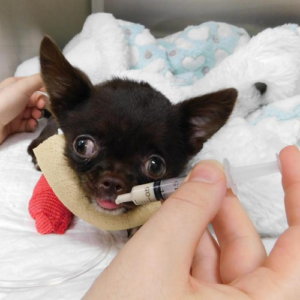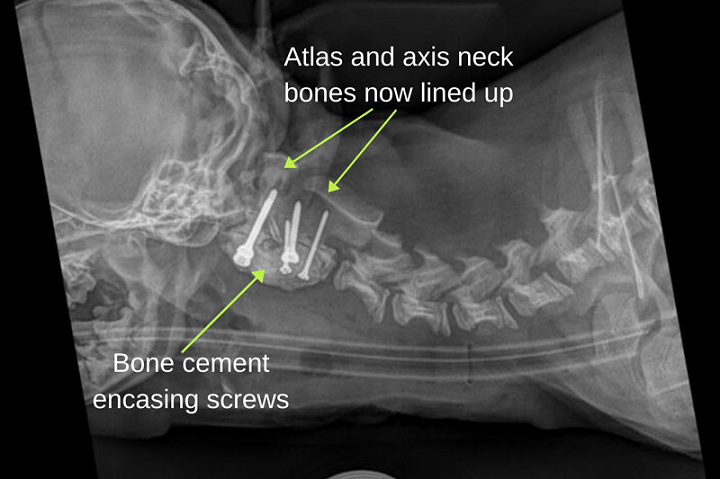Call me sentimental, but I am a sucker for a good story where 3D printing is used to help an animal get back on its feet, especially when the animal in question is a dog. Case in point – the tale of Ping, the paralyzed puppy.

Prior to surgery, Ping had to be hand-fed while he was hospitalized with his neck brace. (Image: Vet Times)
The adorable five-month-old Chihuahua weighs just about one kilogram, or a little over two pounds – less than a bag of sugar. Ping’s owner, Zoe Cekalla, noticed that the puppy was having trouble walking on all of his legs, and when the problem progressively got worse over the course of a week and he became paralyzed, Cekalla took him to her local veterinarian. They were quickly referred to Hamilton Specialist Referrals in High Wycombe, northwest of London. There, veterinary neurologist John Parker took the case.
CT and MRI scans were quickly performed to get to the root of the tiny dog’s problem.
“When Ping was first brought in to us he was depressed and couldn’t walk. The weakness had progressed rapidly and was affecting all of his limbs,” Parker said. “He also had a head tilt and his eye reflexes were reduced. We knew from these signs the problem was localized to his brain or cervical spinal cord.”

A tiny paralyzed Chihuahua can now walk – after it was given a custom-designed 3D printed bionic implant in its neck. (Image: SWNS)
Ping was diagnosed with a severe malformation in his neck, where the bones had not formed correctly. This caused a region of instability, which resulted in direct pressure on his spinal cord that led to his weakness. Parker explained that the technical term for the pup’s condition is atlantoaxial subluxation.
“The first two bones in the neck were partially dislocated. The second neck bone – the axis – hadn’t formed completely and the area needed stabilising to provide Ping any chance of recovery,” Parker said.
“However, Ping was so small – he weighed barely a kilogram – and in such a tiny space, traditional orthopaedic implants would be too large to place safely.”
Ping was then hospitalized, and, in order to prevent any more damage to his spinal cord, had to wear a neck brace. Nursing care kept him comfortable while he waited for surgery. The Hamilton veterinary team used the puppy’s CT images to design bespoke 3D printed surgical guides, which would allow them to accurately place tiny 1 mm diameter screws in his neck to stabilize the area.

The x-ray after surgery shows the atlas and axis bones in line, stabilized with bone screws and cement. (Image: Vet Times)
Six days later, Parker and surgery specialist Michael Hamilton performed the surgery, using the 3D printed guides to precisely place the screws around the unstable part of Ping’s neck. For further stability, the screws were then encased in bone cement.
Ping recovered quickly, and was able to walk out of the hospital on his own, pain-free, just one week later. His owner said that Ping is doing well and happy to be home, which you can clearly see in the video below.
“He’s such a tiny little puppy and I was devastated when he became so weak. When I heard he needed spinal surgery I couldn’t believe such a tiny dog would cope with such a major procedure,” Cekalla said.
“The team at Hamilton’s were fantastic and I can’t thank John, Michael and the whole team enough for all their expertise and care. It truly is amazing that my bionic puppy is back to his normal self so quickly.”
Discuss this story and other 3D printing topics at 3DPrintBoard.com or share your thoughts in the Facebook comments below.
Subscribe to Our Email Newsletter
Stay up-to-date on all the latest news from the 3D printing industry and receive information and offers from third party vendors.
Print Services
Upload your 3D Models and get them printed quickly and efficiently.
You May Also Like
Heating Up: 3D Systems’ Scott Green Discusses 3D Printing’s Potential in the Data Center Industry
The relentless rise of NVIDIA, the steadily increasing pledges of major private and public investments in national infrastructure projects around the world, and the general cultural obsession with AI have...
3DPOD 260: John Hart on VulcanForms, MIT, Desktop Metal and More
John Hart is a Professor at MIT; he´s also the director of the Laboratory for Manufacturing and Productivity as well as the director of the Center for Advanced Production Technologies....
Etsy Design Rule Change Reduces Selection of 3D Printed Goods
Online marketplace Etsy has implemented a rule change requiring all 3D printed goods on the site to be original designs. The update to the site’s Creativity Standards states, ¨Items produced using...
E-Beam OEM Wayland Additive Partners with USC Racing to 3D Print Titanium Exhaust Collector
Every year, standards organization SAE International holds a competition called Formula SAE, in which students from both undergraduate and graduate programs design, build, and race small formula-style race cars. For...


































